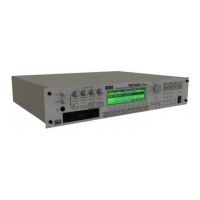52
Layer, split, and velocity switch
Within a combination, you can use keyboard location
and velocity to change the program that sounds. The
programs assigned to each timbre can sound in three
ways: as a layer, a split, or a velocity switch. A combi-
nation can be set to use any one of these methods, or to
use two or more of these methods.
Layer
A setting that causes two or more programs to sound
simultaneously when you play a note on a connected
keyboard is called a Layer.
Split
A setting that causes different programs to sound
when you play in different areas of a connected key-
board is called a Split.
Velocity switch (Velocity SW)
Velocity Switch (Velocity SW) refers to settings which
cause different programs to sound depending on the
velocity (keyboard playing dynamics).
In Combination mode, you can use a different program
for each of up to eight timbres, and combine two or
more of the above methods to create even more com-
plex setups.
As an additional possibility, you can set the slope for a
key zone or velocity zone so that the volume dimin-
ishes gradually. This lets you change a split into a key-
board crossfade, or a velocity switch into a velocity
crossfade.
The Compare function
When 2.1: Ed–Basic–7.3: Ed–MasterFX are displayed,
you can press the [COMPARE] key to make the LED
light. This will recall the combination that had been
written before you began editing. When you press the
[COMPARE] key once again the LED will go dark, and
you will return to the sound that you had been editing.
Use this when you wish to compare the edited sound
with the un-edited sound.
If you continue editing when the [COMPARE] key
LED is lit, the LED will go dark, and the current
sound will now be the sound that is recalled when
the [COMPARE] key LED is dark.
In the section below, we will edit typical parameters in
each page while listening to the effect of each parame-
ter.
For a more detailed explanation of these parameters,
refer to PG p.31–.
Timbre 1–8 program, pan and volume
2.1: Ed–Prog/Mix
Here you can assign programs to each timbre 1–8, and
set pan and volume for each. (These settings can also
be made in the Prog and Mix pages of 1.1: Play.)
Prog page
Program Select
Assigns a program to each timbre.
You can use the “Select by Category” utility to
select programs from 16 categories. (☞p.28)
You can also use the [BANK] and [A]–[H] keys to
select the bank of the program.
If you wish to select programs by receiving MIDI
program changes, do so in P1.1: Play.
Mix (Mixer) page
Pan
Specifies the panning (stereo location) for each timbre.
A setting of C064 will reproduce the oscillator pan set-
ting of the program. Moving this to left or right will
move the sound to left or right while preserving the
pan relationship between the oscillators. A setting of
L000 is far left, and R127 is far right. (
☞PG p.34)
Program B
Program A
Layer:
Two or more programs sound
simultaneously.
Program B
Program A
Split:
Different programs will sound in
different areas of the keyboard.
Program A
Program B
Keyboard playing dynamics
Velocity Switch:
Keyboard playing dynamics
(velocity) switches between
different programs.
Strong
Soft
Program C
Program D
Keyboard playing dynamics
Program B
Program A
Example:
B and C, D are split. In the lower
keyboard range, A and B are
layered. In the higher keyboard
range, C and D are switched by
velocity and layered with A.
Strong
Soft
Program A
Program B
Keyboard X-Fade (keyboard crossfade):
As you play from low notes to high notes,
the volume of A will fade out, and the
volume of B will fade in.
Program A
Program B
Keyboard playing dynamics
Velocity X-Fade (velocity crossfade):
As you play with increasingly stronger
velocity, the volume of A will fade out, and
the volume of B will fade in.
Strong
Soft

